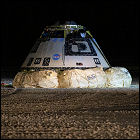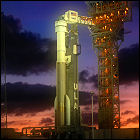Starliner grounded
 After Boeing discloses major software glitches that had previously gone unannounced from December’s uncrewed test flight of the human-rated CST-100 Starliner space vehicle, the vehicle is grounded pending a second test flight that can demonstrate the issues in question have been corrected. The software glitches include the onboard computer’s event timer being off by 11 hours, and a second glitch, had it not been discovered, would have caused the Starliner command module and its separated service module to collide before re-entry – an event likely unsurvivable in a crewed mission. Boeing and NASA will both participate in the investigation of the issues before certifying the Starliner for another flight.
After Boeing discloses major software glitches that had previously gone unannounced from December’s uncrewed test flight of the human-rated CST-100 Starliner space vehicle, the vehicle is grounded pending a second test flight that can demonstrate the issues in question have been corrected. The software glitches include the onboard computer’s event timer being off by 11 hours, and a second glitch, had it not been discovered, would have caused the Starliner command module and its separated service module to collide before re-entry – an event likely unsurvivable in a crewed mission. Boeing and NASA will both participate in the investigation of the issues before certifying the Starliner for another flight.
The Starliner’s first landing
 Boeing’s CST-100 Starliner space vehicle ends its uncrewed maiden voyage by successfully landing with its combination of parachutes and impact-cushioning airbags at White Sands, New Mexico. Intended to visit the International Space Station on its first flight, the Starliner’s flight plan changed unexpectedly when a software and sensor mishap during launch put it into the wrong orbit, and used more fuel than expected, making it impossible to reach the same orbit as the ISS. Despite the mishaps, both Boeing and NASA expect the Starliner’s second flight, scheduled for 2020, to include a crew of astronauts.
Boeing’s CST-100 Starliner space vehicle ends its uncrewed maiden voyage by successfully landing with its combination of parachutes and impact-cushioning airbags at White Sands, New Mexico. Intended to visit the International Space Station on its first flight, the Starliner’s flight plan changed unexpectedly when a software and sensor mishap during launch put it into the wrong orbit, and used more fuel than expected, making it impossible to reach the same orbit as the ISS. Despite the mishaps, both Boeing and NASA expect the Starliner’s second flight, scheduled for 2020, to include a crew of astronauts.
The Starliner’s maiden voyage
 In development since 2010, Boeing’s CST-100 Starliner space vehicle lifts off atop an Atlas V rocket on its first flight, scheduled to take it to the International Space Station. A software and sensor mishap after second stage separation results in the vehicle putting itself into an orbit unable to reach the station, after burning enough fuel to make a major orbital correction impossible. Boeing and NASA settle on an alternate flight plan to allow for other engineering tests in orbit before the vehicle’s planned return to Earth on land a few days later. There is no crew aboard for this first flight, though Boeing contends that astronauts aboard might have been able to override the engineering problems that resulted in the incorrect orbital insertion.
In development since 2010, Boeing’s CST-100 Starliner space vehicle lifts off atop an Atlas V rocket on its first flight, scheduled to take it to the International Space Station. A software and sensor mishap after second stage separation results in the vehicle putting itself into an orbit unable to reach the station, after burning enough fuel to make a major orbital correction impossible. Boeing and NASA settle on an alternate flight plan to allow for other engineering tests in orbit before the vehicle’s planned return to Earth on land a few days later. There is no crew aboard for this first flight, though Boeing contends that astronauts aboard might have been able to override the engineering problems that resulted in the incorrect orbital insertion.